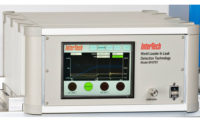Advanced technology for leak testing now provides opportunities to improve quality and save money even in applications where expensive helium systems are customary. As the price of helium rises and supply runs short, modern manufacturing must stay abreast of the realities and economics of leak testing or profits and customers may evaporate.
Because manufacturing has become so complex and fast-paced, process trends need to be rapidly identified for defects and deviations. Choosing the best leak testing method for a given application has grown in importance. Sound choices bring down costs, improve yields, and minimize risks.
Various types of leak testers are available, but many are either too costly, have slow test cycles, or their operation is too complex to be considered for a production line environment. Here are the most common ways to test for leaks:
-
Mass flow, which is very fast and a good fit for a wide range of leak detection, is used for everything from medical devices to automotive parts, castings and industrial components. State-of-the-art sensors accurately and quickly measure leaks smaller than 0.5 sccm, and automatically compensate for environmental factors such as temperature.
-
Pressure decay (or rise) is frequently used in testing of automotive, medical and consumer goods, but is inherently slower than mass flow. Instruments can be cheaper than other methods, but will be more sensitive to part variations and more sensitive to ambient conditions, which is a major factor in total cost of ownership. Differential pressure decay is a more accurate version of pressure decay but is also more expensive.
-
Helium mass spectrometry is among the most expensive leak testing methods used to find micro leaks in items such as air conditioning components and air bag systems. This method is insensitive to part variations such as expansion and temperature. However, vacuum pumps, nitrogen purges and stringent maintenance are expensive and time consuming. Helium consumption is another source of higher cost.
- Dunk testing is the most basic, low-cost leak test method (although for a “cheap” method it carries many hidden costs, i.e. water filtration and drying steps). Unlike the methods described above, it offers no quantitative data and is nearly obsolete, but still viable for low precision, pass/fail testing.
These methods have been used with excellent results for decades, but over time, the methods have undergone numerous permutations. This is the response of the leak-testing industry to the growing needs of different applications and associated regulatory requirements.
Stop the Confusion
Variations in leak testing methods, technology and capabilities all too often are cause for confusion among manufacturing engineers, and even some quality control/quality assurance (QC/QA) professionals. Nowhere is this more evident than with mass flow. In particular, it is important to understand that some mass flow leak testers use commercial off-the-shelf sensors, which are patently inferior to application specific sensors built from the ground up for the unique requirements of mass flow leak testing.
Compared to generic ones, advanced mass flow sensors provide an advantage in the factory setting by maintaining high measurement accuracy across a wider range of air pressures and temperatures, ambient temperatures, and random short-duration disturbances. In this way, leaks as small as 0.01 sccm are accurately tested with 10-percent gage R&R, with no need for helium or the associated costs and complications.
Leak Testing Choices and Opportunities
Whether the objective is to measure leaks in a heat exchanger or in a fuel injector, helium is not the only choice. Leak testing can be cheap or expensive, and it can make the difference for corporate success and profitability. Selection of leak testing methods is a serious matter that often forces economic and practical choices that include total cost of ownership.
Since there are many possible approaches, it is always best to consult a testing specialist with experience in your application. Feasibility studies and early collaboration uncover real costs and opportunities that create the best foundation for maximum efficiency in any leak testing system.
Rising Cost of HeliumRefined helium prices have more than tripled from 2000 through 2012, according to the National Resources and Environment U.S. Government Accountability Office. For the last century, the United States has been a major supplier of crude helium, and currently accounts for 30% of the worldwide supply. In October 2013, that supply is expected to cease per government legislation. Quick and bipartisan action from Congress is needed to avert a helium shortage. Expectations are for prices to skyrocket as supply for helium drops like a lead balloon, transforming the U.S. from a major exporter to a net importer. Significant new sources of helium from Qatar and Russia are not yet online, and the trend toward “fracking” for natural gas suppresses the market yet more. Lawmakers are now considering acts to create a softer landing for the helium market as it heads toward what some call a “helium cliff.” Demand, however, is up worldwide and shortages now exist. According to Samuel Aronson, vice president of the American Physical Society, national labs such as the one in Oak Ridge, TN, have been forced to make do with two-thirds of the helium ordered in recent months. Why is Helium Up?
|
Types of Leak TestingThere is no standard answer as to which leak testing method is best suited for a particular application. Here are some of the variables to consider when weighing the options. Bubble Testing Pros:
Cons:
Pressure Decay Pros:
Cons:
Differential Pressure Decay Pros:
Cons:
Mass Flow Pros:
Cons:
Helium Testing Pros:
Cons:
|



